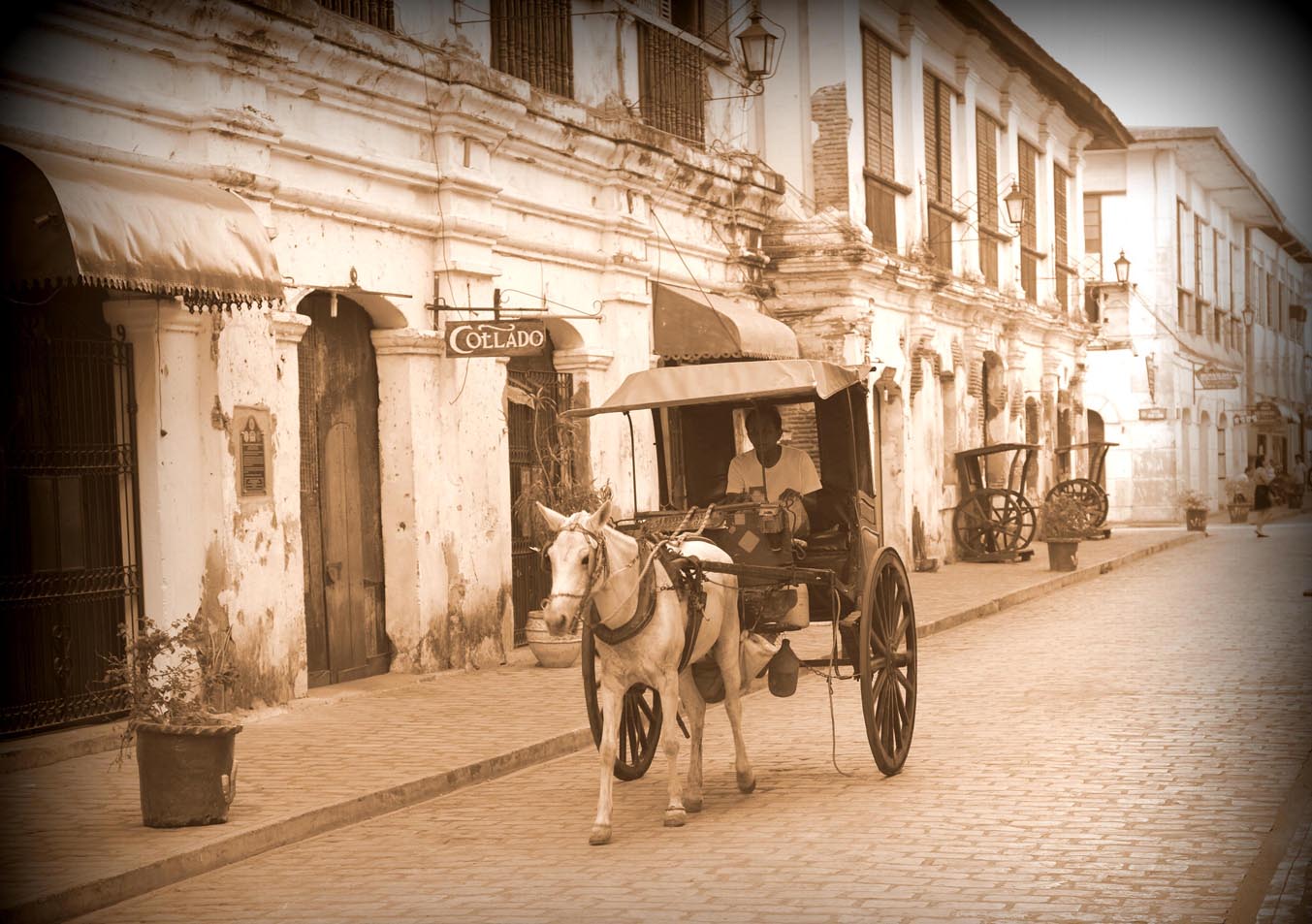When I joined Binondo Heritage Group in Facebook six months ago, little did I imagine how it would greatly encourage me to find out more about my roots. Composed of Tsinoys like myself, many of whom were born and raised in the Philippines, interacting with BHG was very happy and enjoyable because I have been in America for the last 25 years. I speak English with my patients at work, Putonghua with my wife. We don’t speak Tagalog and Hokkien at all. I now realize that I was not able to speak Tagalog and was not able to appreciate my homeland.
In the past six months, the discussions about our ancestry and family history ignited the desire to know my own family. My grandfather, Chan Teh (曾瑞地), left Fujian, China in 1908 at the age of ten and settled in Vigan, Ilocos Sur. My father, Francisco Chan (曾振基), was born in Vigan. My last visit to Vigan was 40 years ago. I never thought then I would want to go back and learn more about the place.
When I decided to visit Manila this year, I asked my brother and sister to arrange a trip to Vigan. My father is 82 years old – I would like to bring him back to his birthplace one more time. I would like to visit my grandfather’s old house one more time, and try to connect with him: he passed away three years before I was born.
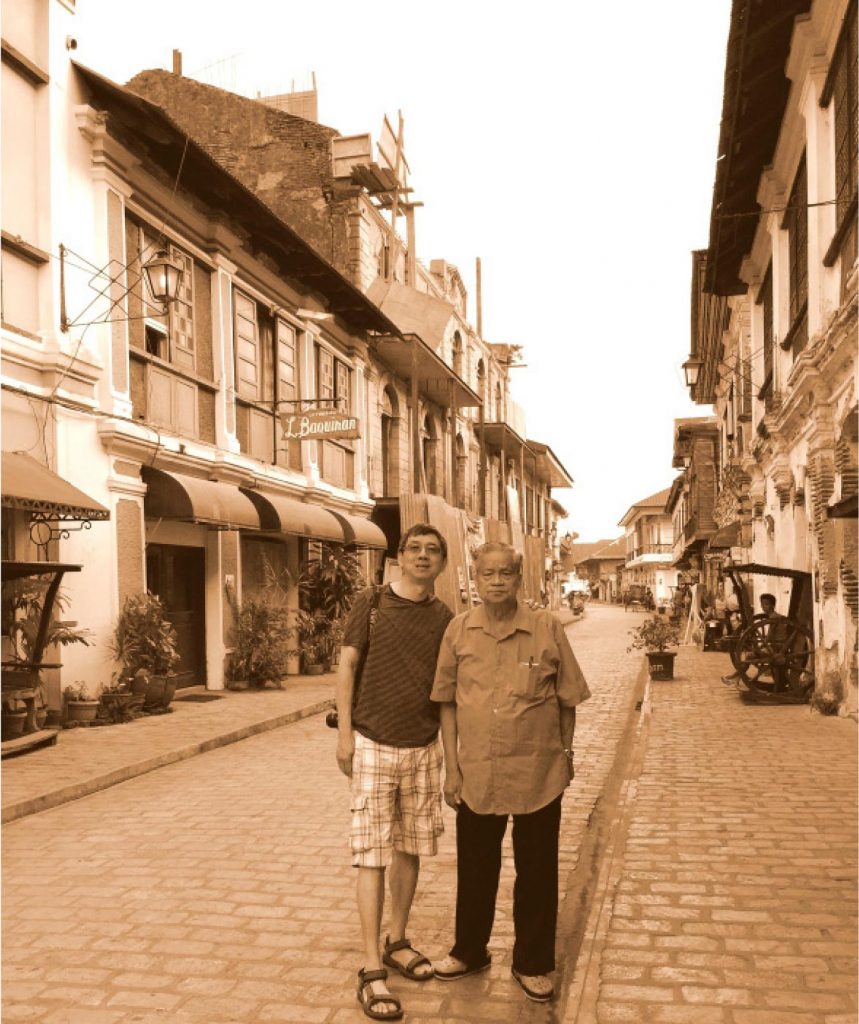
Day 1, March 6, 2016, Sunday
Incense
That is the only way
that we communicate
Every time I go home
Every time I am about to leave
Dad said
Pa, Benna has come home
As if we instantly invited you back
As if you touched my head and said
My grandson, my good grandson!
And when I am about to leave
Dad said
Please protect Benna
I leave
As if carrying an amulet
Like the day you left for
South Pacific
Brave
Marching forward
That Sunday morning, after lighting four incense sticks, I stood in front of Angkong’s and Ahma’s pictures.
“Angkong, we are leaving for Vigan, please bless our trip. I want to write your story. Please show me where to get information. Thank you!” I silently prayed, then made four bows and planted the incense in place.
A quick breakfast at McDonalds provided the needed caffeine and calories to start our 12-hour adventure into northern Luzon. It has been more than 30 years since I last ventured into the provinces. Everything is new to me. The new expressways rival those of American freeways. We got to Urdaneta, Pangasinan in about two hours.
My father used to travel to those cities when he was a salesman. My brother Milo said that 20 years ago, they went to Ilocos without a map, with just my father’s memory as guide. My father was sitting at the front passenger seat. I noticed that he loves to be a “front seat” driver.
“It is open now, pass that tricycle!” He would say.
When we got to Rosario, La Union, there was a sign pointing to the right: Baguio. I was navigating with the app Waze. It showed left. Shortly after we passed that sign, he yelled, “Wrong! Do not use this route. Go back! There is a short cut there!”
Well, should we trust a smartphone app or someone who had traveled this area frequently for years? One solution was to stop and ask. We stopped twice. Both tricycle drivers said we are on the right highway.
Just to verify, I checked the bigger map. My father was right. If we were to go right towards Baguio, we can go through Pugo and still get to Agoo. Based on the map, it is not a shorter distance. After 20 years, the roads are different. The left route later proved to be okay.
My father’s memory test next came when we got to San Fernando, La Union. When we reached a park, he said, “Turn right here. We can check out the Chan-Cu Association building.”
The day was still early. My brother made the turn, curious to see if he was right. Two blocks away, we saw the two-storey building on the left street corner. Voila! Philippine Chan-Cu Association of Northern Luzon. After 10 hours, we reached the city of Vigan. I recognized the place because I have been doing my research.
I have many questions: Did my grandfather settle in Vigan directly? Did he stop by Manila first? What happened to his business? What was Vigan like during the Japanese occupation? What was grandfather’s business name?
For dinner, we went to Cafe Uno for Ilokano food. My father enjoyed it. Pointing at the empty dishes, he said, “Ilokano food!” as if he was back to his childhood days. I was hoping that stuffing him with comfort food will make him tell us more stories about Vigan and my grandfather. The trick worked.
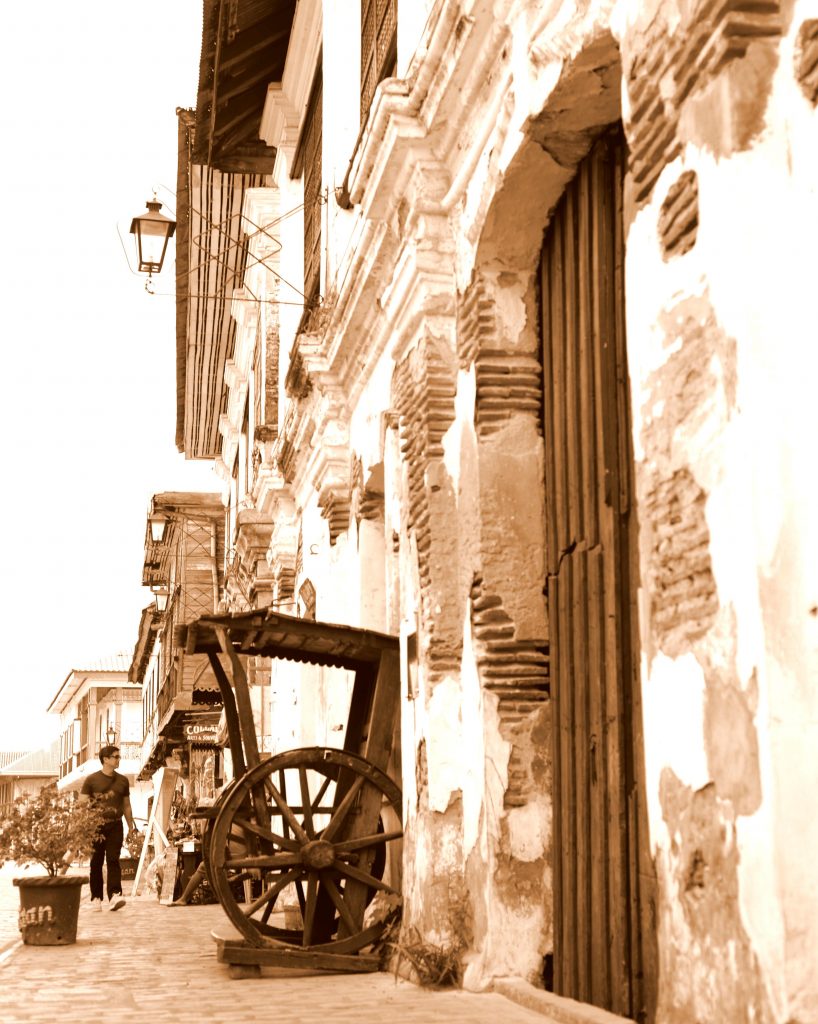
Day 2, March 7, 2016, Monday
Grandfather’s Old House
Maybe
We should talk in Ilokano
Maybe
I should have visited more often
Maybe
When my father was telling me your story
I should have listened more
Now
Your walls have faded color
Now
Your balcony has only one left
Now
All I can hold on to
is just a photograph
But
There you are
Standing
For me to see
For me to hear
The story of my grandfather
When I visit you next time
I shall bring sampaguita
I shall hang it on your door
For you
For grandfather
So that grandfather can smell the fragrance
Of the flower and return
And we all can have a visit
The next morning, at day break, I grabbed my camera and went to Calle Crisologo, which is just one block from Hotel Luna. I wanted to feel what Vigan was like in early morning. The birds were chirping. The rooster crowed. This is a totally different world from the big city.
Calle Crisologo was almost empty compared to the crowd-filled street last night. I went back to my grandfather’s house.
In the daylight, I can see better. What caught my attention was the nice wooden carvings above the windows. It is an example of fine woodcraft from 80 years ago. At the top of the house, a green plant peeped out from the cracks in the concrete.
Life can be hard but living things always find a way to survive. I am reminded of my grandfather’s story, leaving poverty stricken south China in the early 20th century and crossing the South China Sea to start a new life. I went back to the hotel and joined the others for breakfast.
Mr. Lao arrived later, as promised. Meeting him was by chance. When we checked in the day before, my brother Milo spoke to the front desk clerk. After learning about our last name, she mentioned a certain Mr. Chan. Later on, on our way out for dinner, she told my brother that “Mr. Chan is having dinner here right now.”
Milo spoke to Mr. Chan. One thing led to another, and it led us to Mr. Lao, who is a very generous person. He asked his son to drive another car and bring us to different places like Vigan Nan Chong School, Filipino Chinese Chamber of Commerce and two hardware stores.
Imagine this. I stood in front of a hardware store which I have never been to. All I know is that there is a Mr. Tan. I walked in and asked the first person, “Is Mr. Tan here?”
The person turned and looked back, “Pa, someone is looking for you!” he shouted.
I followed the direction where he was looking. A Chinese gentleman in checkered blue shirt and black pants was standing behind the counter.
When he came closer, I extended my hands and said, “Uncle, Dr. Gideon Chan asked me to talk to you.”
At the same time, my father walked in. They looked at each other and smiled. Simultaneously they said: “I know you!” We gathered around the small open area inside the store and sat on plastic chairs. I call it oral history session. The only way for me to find stories about my grandfather is going to be that way!
The next stop was Mike’s Department Store. I got to know of Merlita through my classmate in medical school. We never met, but the quick introduction to my father led to another oral history session. And so it went throughout the day. One name led us to another person. It was also another test of my father’s memory. With all the turns and one-way street, he was able to find another hardware store, New Born Hardware.
We went back to Calle Crisologo looking for a Mr. Chua. This time, my father’s “radar” did not work. After blocks and blocks, no Mr. Chua. Or maybe, Mr. Chua moved or died. I realized then that my grandfather’s peers are dead. And those of my father’s generation are either dead, deaf or demented. I came to this tracing of roots journey a bit too late. We did not find Mr. Chua but found a pizza place. That was dinner for me. After days of restaurant food, a few slices of pizza sufficed for me.
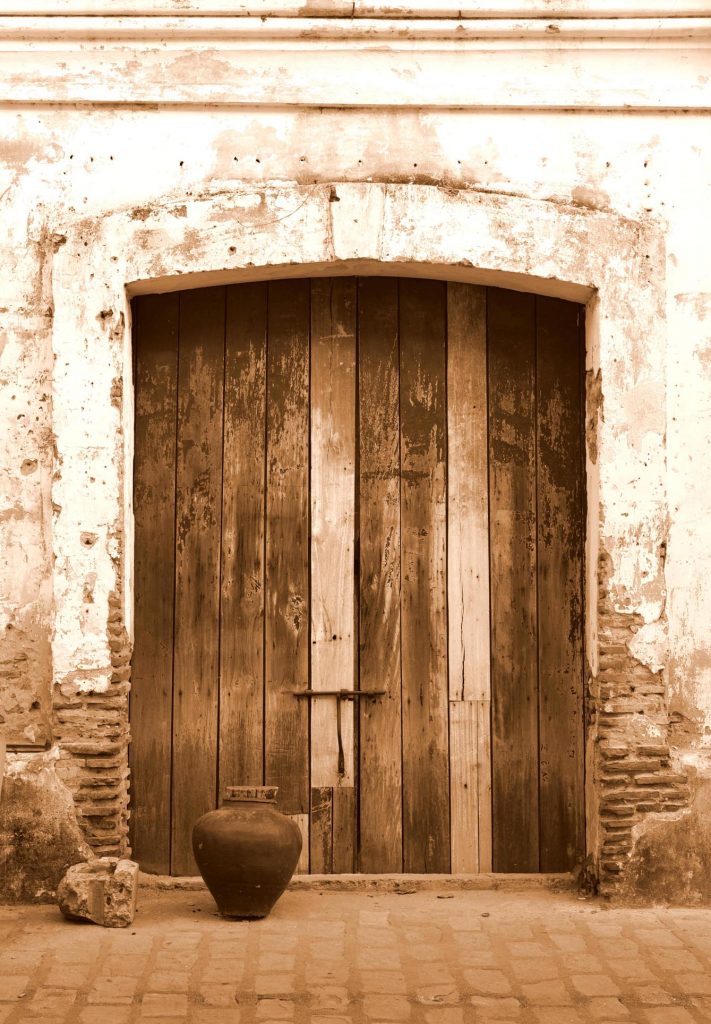
Day 3, March 8, 2016, Tuesday
My prayer was answered the next morning. I went to my grandfather’s old house again. I hoped to see the renovating crew, which I did, and they let me in. I was able to climb to the second floor. I took a picture of the arch, showing the original thick concrete front. The wooden floors had been replaced with concrete. There is an opening in the middle ready for an elevator.
After breakfast, we went to Crisologo museum, which contained a big collection of historic artifacts. It gave me a better understanding of what my grandfather’s house looked like. It had wooden floors, big windows with panels made of capiz shells, old wooden furniture, kitchen with clay pots and clay stoves and an interesting pig toilet.
We drove to the plaza for Chinese food, then headed for the municipal library. We browsed through dusty old magazines but found nothing. The next stop was the old jail that had been converted into a museum. We had a glimpse of what former President Quirino was like. According to my father, Quirino was a close friend to grandfather.
The next was shopping for the famous Ilokos vinegar for friends in Manila. Then I stopped by Tessie’s Restaurant. I learned about this place from BHG member Pao Chan. The family was very nice. I found another piece of the puzzle. Pao Chan’s grandfather, Pedro Chan Sr., has an older brother who stayed at my grandfather’s old house. The next task is to know his Chinese name.
Dinner was special. Shirley Chan is the daughter of my godfather, Alexander Chan. She invited us for dinner and provided us with another piece of the puzzle. Her uncle lived in my grandpa’s house too. And her cousin is still alive and lives in Manila. Her name is Auring. We picked up the phone and called and a visit was scheduled for Thursday.
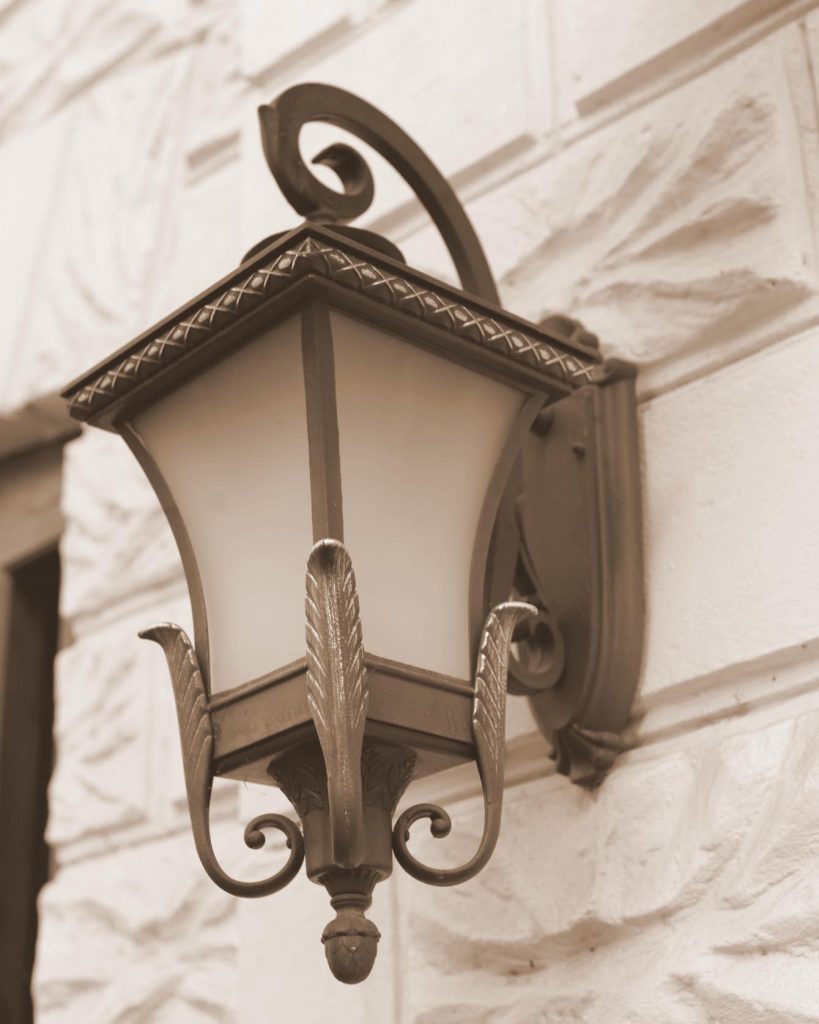
Day 4, March 9, 2016, Wednesday
On the fourth day, I went back to Calle Crisologo one more time. This time, I brought my father. He had suffered a stroke last year. His memory is not good, partly probably from aging and partly from stroke.
As a physician, he is a “challenging case.” I do not have a clear diagnosis. Being the son, I know that I should not treat him. I leave his treatment to his physicians. A few thoughts came to my mind as we slowly walked to Calle Crisologo. As human beings, we like other people to behave how we would behave. I often say to myself that when I get old, I would do things differently.
But we are who we are. I believe that we are hard-wired at birth to behave and think in certain ways. This is what I learned in this trip.
I learned to forgive and accept my father. He is my father. He has done things that are difficult for people around him. He came to this lifetime playing the role of a difficult person. At the same time, he is also a very responsible person who raised seven children and helped his younger brother to become a doctor.
After a short walk from the hotel, I sat him down on one of the benches along Calle Crisologo, facing the old house. I do not know what was on his mind. How does it feel to be in front of the house where you spent your childhood days 75 years ago? Does it bring back memories?
I took more pictures with him. I noticed that the house behind us has a plaque about the history of the house; it mentioned the Singson family. I told him that. He said, “Yes, they live across from us!”
Well, he was right again. That is the state of his memory now, muddy but with very clear moments. Whether navigating around the city or saying names, he was spot on from time to time, which led me to write the following poem:
Vigan
If everything will disappear
Not this city
For my dad
He can walk around
With eyes closed
Left
Right
Straight ahead
It seems that we are making circles
But every time
He is right
Is this what it means to get old?
Everything will disappear
Not this city
On our way home, we stopped by Angeles City to meet my cousins. Their father, Manuel Chan, is my second oldest uncle. Cousin Angelito gave me more information about my grandfather. My grandfather passed away when he was nine years old. He gave us a good description of my grandfather’s character, his business and his final days.
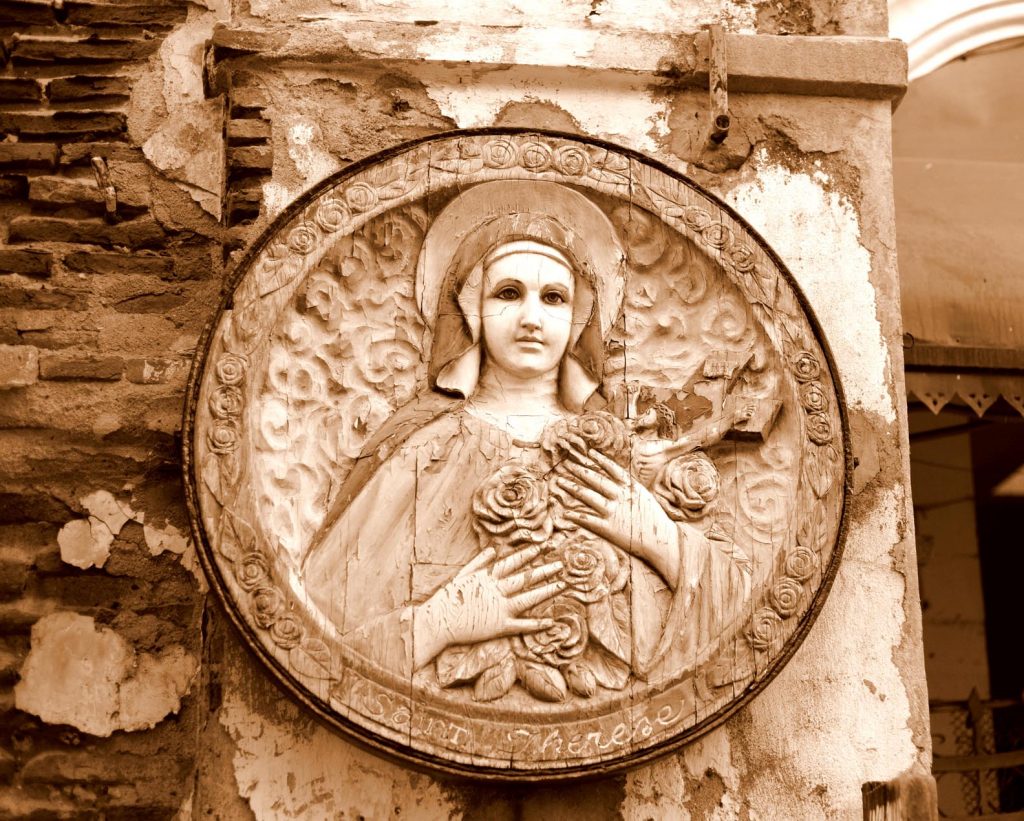
The Day After, March 10, 2016, Thursday
I had a chance to meet auntie Auring who grew up in Vigan and had lived in the old house before. I felt that my grandfather had been guiding me all along during this family history search. He actually saved the best for last.
In summary, this is what I found: My grandfather was born in 1898. He came to the Philippines with his cousin in 1908 at the age of 10. He went directly to Vigan. There, he was able to learn the trade of doing business, saved enough money to return to China and married my grandmother at the age of 20.
He had two other business partners at that time. They opened a big business along the main street which is now Calle Crisologo. They had a four-storey house where the first floor was the store front. It was called Lian Huat (聯發). The second and third floors were living quarters occupied by more than one family. He was the manager of the business and the building was registered under his name.
When the Japanese came in 1941, many Chinese in Vigan fled. They heard about all the bad things that the Japanese were doing in the Philippines. After some time, when things settled down, they returned to Vigan and restarted doing business. Somehow the business partnership fell apart, so my grandfather brought his family to Manila. They lived in Chinatown, along Benavidez Street, in a building owned by the Ong Family Association. The house burned down a few years later.
My grandfather was described as very intelligent and generous. He spoke many languages including Tagalog, Ilokano, Spanish and Hokkien. He was well-received and respected. He was also very good with law, thus, people asked for his help. Life was very hard because of the big family. Eventually, he got sick, was initially brought to Quirino Memorial Hospital, then transferred to Chinese General Hospital. He died in 1958, at the age of 60, three years before I was born.
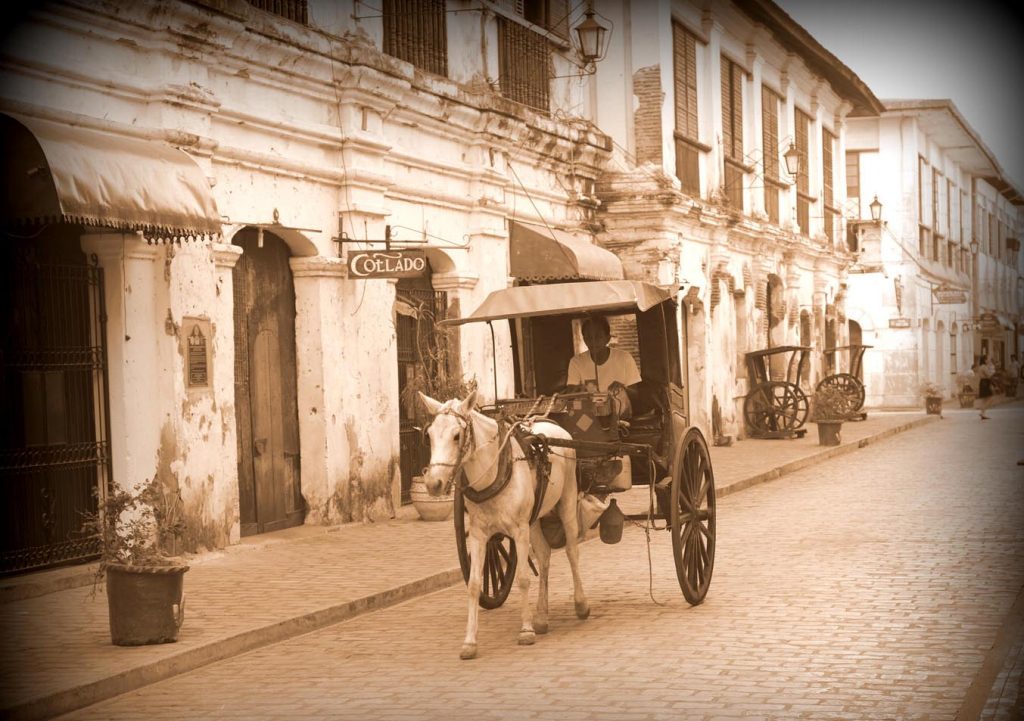
Today, I have a better understanding of my grandfather, my father and myself. I am glad that I revisited Vigan. In closing, I would like to share a Tagalog poem about my grandfather:
Ang Buhay ni Chan Teh
para kay angkong
Sa wakas
Mas malinaw na ang istorya
Isa-isa kong pinagdikit
Parang jigsaw puzzle
Gaya ng marami sa kanyang
Kababayan sa Tsina
Umalis siya, tumawid ng dagat
Noong sampung taon siya
Para makatulong sa pamilya
Yan ang dating OFW
Vigan ang naging pangalawang
Bahay niya
Nagtrabaho, nakaipon
Umuwi at nag-asawa
Lumaki ang pamilya
Lumaki ang negosyo
Lumaki din ang problema
Noong dumating ang mga Hapon
Nasira ang negosyo
Nasira ang buhay
Umalis na naman
Manila ang pangatlong bahay
Nirerespeto, mabait,
Maganda ang kanyang kalooban
Hanggang wala na siyang maibigay
Kundi buhay niya
Natapos ang lahat
Sa Chinese Gen
Huling mga salita
Noong sisenta anyos
— First published in Tulay Fortnightly, Chinese-Filipino Digest 28, no. 22 (April 19-May 9, 2016): 14-16.
